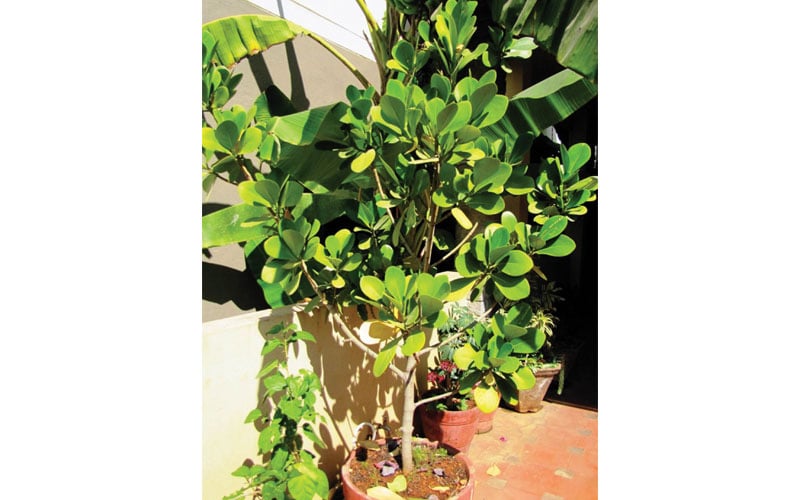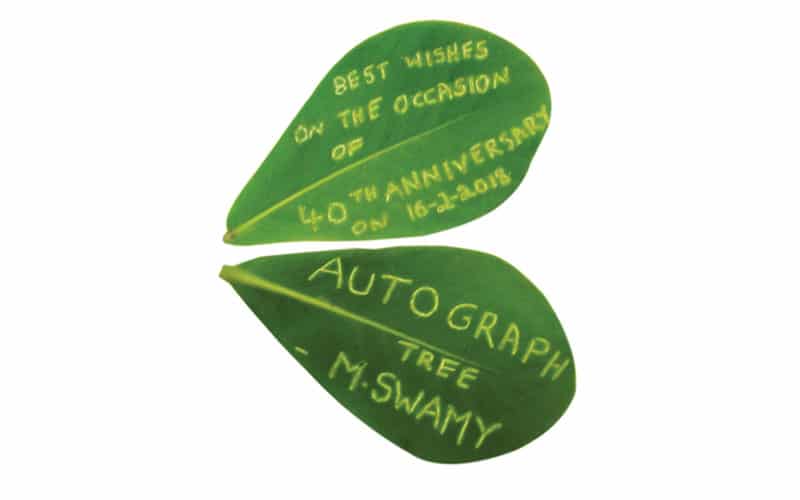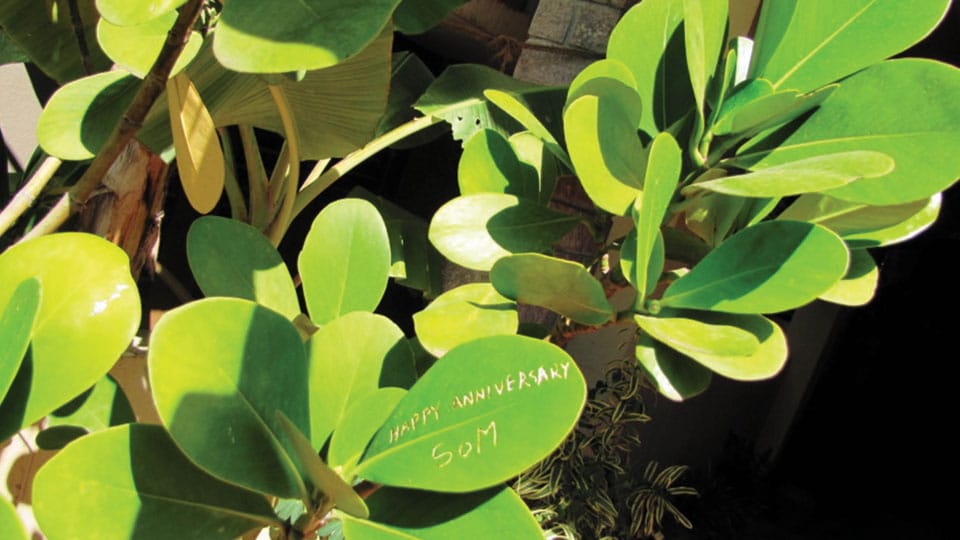Text & photographs by Dr. Mahadeswara Swamy, Scientist
Mob: 97429-91057 e-mail: [email protected]
People often write names, messages, notes and even autograph on rocks and walls. Can these be done on plant leaves? Can such writings remain for quite some time? In general, it is not possible, as the leaves either get disfigured with scratch mark, dry up or even torn out.
But ‘yes’ on the leaves of ‘Autograph Tree.’ One can engrave or inscribe message or signature with a sharp object or an empty ball point pen refill on the leaf surface and the impressions remain as long as the leaves are appended to the tree as the large, stiff, thick dark green waxy leaves are unique with special feature. The inscribed areas become white and more prominent the next day as if painted white!
It is a tree with outstanding ornamental features like dense foliage and attractive fragrant flowers, also known by other names such as ‘signature tree,’ ‘pitch apple,’ ‘monkey apple.’ The tree gets its common name ‘Autograph Tree’ because of its leaves. It is native to Caribbean islands and common in tropical and sub-tropical regions of the world (Hawai, Madagascar).
The scientific name is Clusia rosea, a close relative of mongostein tree belonging to the family ‘Clusiaceae.’ The generic name ‘Clusia’ is in honour of the 16th century Netherlands Botanist Carolus Clusius. The specific name ‘rosea’ is in allusion to its rosy petals.

Bio-data: It is a compact, medium-sized evergreen tree with a short trunk and smooth bark with yellow sap, often reaches a height of 25 ft and above in its nativity. The tree has dense foliage and a spreading crown. The branches droop down as the tree grows. It produces aerial roots, hanging down from the trunks. The spatula-shaped simple leaves are thick, dark green, waxy, glossy, shiny and leathery. The leaves are opposite/sub-opposite in position with entire margin, 6 to 10” long. The showy flowers with off white and pink centres are produced at leaf axils or tips of the shoots. These flowers are unisexual and slightly fragrant during night. The thick sepals, 6-8, are almost semi-circular and yellowish brown. The fleshy and glossy petals, 6-8, are often notched at the tip and obovate (like spatula) to nearly round in shape, 3-5 cm long, with a round of numerous yellow stamens arranged at the bottom. The ovary is multi-carpellary. Flowers appear during January-March. The apple-like green fruits are woody capsules, 3-4”. They turn brownish or blackish when mature and split open like a wood rose from the top along 7-9 or more seams revealing the red seeds in the resinous glue.
Gardening
The tree grows well in warm and humid areas in full shine to dapple shades, depending on the light intensity. Any type of soil is suitable (clay, loam, acidic, alkaline), dry or moist, but grows most rapidly in well-drained moist soils. The trees can be propagated by seeds, cuttings and air-layering. Air-layering is preferable over cuttings. There are a few attractive varieties like ‘variegata’ with striking yellow and green foliage.

Useful Tips
- The trouble-free ornamental tree is suitable for home and public gardens and looks elegant when planted in the corner of a lawn.
- It can be grown in big pots and also makes a good specimen for bonsai.
- The tree is tolerant to salt, salt spray (aerosol salt) and drought and do not fall down easily during rain or wind.
- Sow the seeds as soon as possible as they do not store well. Bag the seed heads to capture the ripening seeds.
- When grown in pots it often overgrows. Carefully remove the root ball out as a whole and transfer to a larger container which can accommodate the root system.
- Train the plant to grow with a single trunk (central leader) by pruning side branches.
- The autographed leaves can be dried in the folds of a book and can be preserved.
- It attracts birds (humming birds), butterflies, insects and
- Parts of the plant, especially the seeds and sap are poisonous if ingested.
- Handling plant may also cause irritation or allergic reactions. Better to wear hand gloves.
- Most importantly, it is a strangler tree* similar to strangler figs. The seeds can germinate in crotch of any tree and grow as epiphytes. As they grow, they send down aerial roots and eventually smother (strangle) the host trees to death!
- The autograph tree has the unenviable distinction of being listed in the Global Compendium of Weeds.
* P.S: Clusia rosea is a hemi-epiphyte as it begins its life as an epiphyte (growing on another tree or structure) and gets itself transferred to the ground by sending the roots. Once it establishes, it overgrows and eventually chokes the host tree to death. Hence, it has earned the distinction of dangerous invasive species in several tropical countries.
Where to see
Private gardens. I have one in my home garden.








Recent Comments